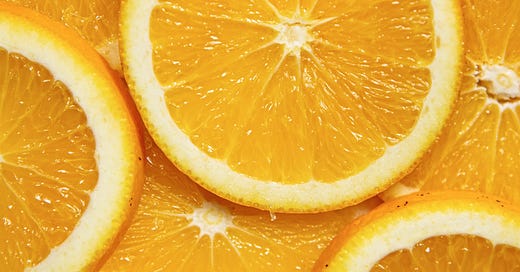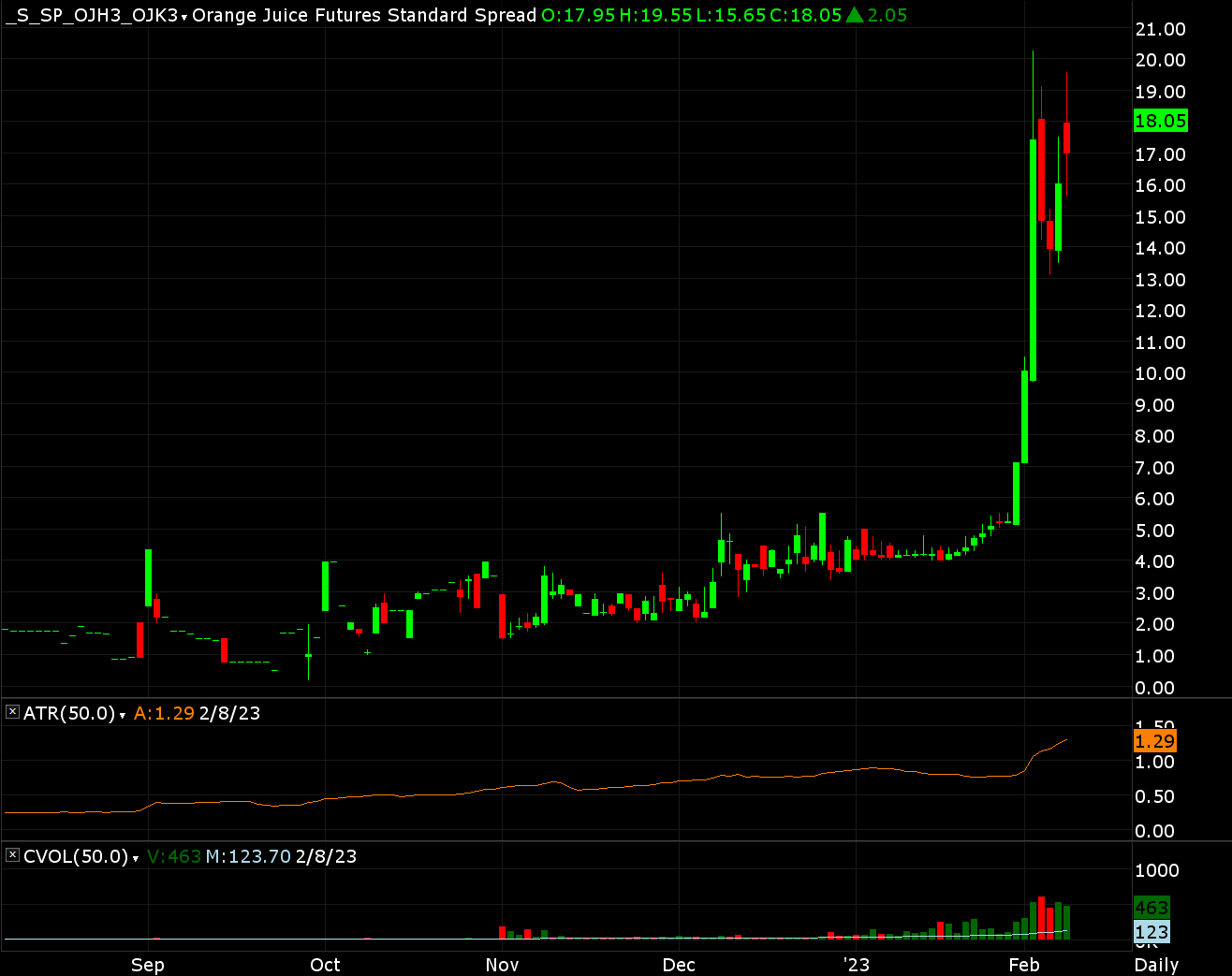Yesterday, Frozen Orange Juice futures have continued their amazing rally, now up 11 days in a row. The March 2023 (H23) contract settled at $2.5695 per pound a new all-time high. Looking at the H23 chart, this is an upside breakout to remember!
The main reason behind the rising cost for the breakfast staple is Florida's meager harvest. Farmers are expected to harvest just 18 million 90-pound boxes this year after a freeze, two hurricanes, and a citrus disease laid waste to the crop. That's half the size of last year's harvest and a whopping 93% decline from Florida’s peak production in the late 1990s.
Trend following traders are long OJ futures since at least mid-2022. Our 2Q system signaled a long entry even earlier, on 6 January 2022, pointing to the January (F) 2022 contract at the time.
Compared to our entry price of $1.1645 in January 2022, the notional contract value of OJ futures has more than doubled (about $39K per contract now vs. $17K back then then).
Moreover, the contract’s average true range (ATR) - a measure for volatility - has increased substantially in recent weeks. The current 50-day ATR is around $5, and the 20-day ATR around $7. Combining this ATR with the contract’s point value of $150, the expected daily P&L of each contract is 5 x $150 = $750.
In our 2Q portfolio, we’ve retained our original position size from January 2022. We refused to “peel off” risk by reducing the number of our long contracts at rollover dates or in response to increased volatility and notional exposure. As a result, OJ has grown into a very dominant position inside the 2Q portfolio over time. Nothing moves the needle more than orange juice right now!
Is this good or bad?
It depends on who you ask. Many trend following CTAs apply a dynamic position sizing overlay which alters the original position size in response to the underlying market’s as well as the aggregate portfolio volatility. This is also known as “volatility control” or “volatility stabilization.” When volatility control is applied to the entire portfolio, it also responds to changing correlations and not just rising or falling volatility at the market level.
In the case of orange juice, a volatility control overaly would have reduced the position size, resulting in smaller profits and reduced positive skewness. This is a snapshot as the trade is still live and not yet closed, i.e., things can still change, but from the perspective of a purist trend following trader, reducing size when you’re supposed to let winners run (and cut losers short) seems to be the wrong trade. Trend following trades understand that you can go broke taking profits prematurely.
Personally, I like to stay away from these sort of overlays. I think they’re a way of introducing mean-reverting trades into a resilient, trend-based system that’s designed to do the opposite of mean reversion. It’s tempting to add features that can smooth the P&L and increase its Sharpe ratio, but these features have side effects. My research shows that they increase my average loss per trade and reduce the positive skewness of my closed trade distribution.
Furthermore, I wouldn’t even know how to count these trades for sample size purposes as they are triggered by changes in volatility and/or correlation rather than a price breakout.
I’d be very keen to see an analysis and P&L breakdown by the CTAs which have integrated dynamic position sizing into their trend systems. I’d like to see a P&L chart which shows the contribution of volatility controlling trades in isolation over time. Is this equity curve going from the bottom left to the top right? I doubt it. If it doesn’t, why do it?
While we notice that orange juice is now a larger and a more volatile component of our portfolio, we believe that we can and should treat open trade equity different to closed equity. We can be more “liberal” with the former as is consists of profits which we obtained from the markets in the form of variation margin, i.e., it’s other peoples’ money that we can continue to trade with, but we’re very protective of the latter and hate it when the markets eat into it. Viewed this way, we can worry less about our give-back risk as our exit level in the case of orange juice still sits well below $2.
Put differently, even if orange juice gapped down to our exit right away, we’d close the trade with a very nice gain given our entry level of $1.1645. What’s not to like?
We also don’t want to make predictions on future prices. Can orange juice move higher than $3, $4, or even $5? Of course it can. We don’t know the odds of that happening, but our system will be there if it happens. That is what robust systems are meant to do.
One possible, but not guaranteed, way of reducing some exposure is an earlier-than-usual rollover. Usually, the front contract has more volatility and beta than the contracts further down the forward curve, and rolling from March (H) to May (K) ahead of will likely dampen volatility a bit while retaining the long exposure in OJ at full contract size.
Here’s the spread between H and K.
March trades 18.05 cents higher than May. In our 2Q portfolio we rolled a part, but not all, of our long orange juice position early at around that level, i.e., selling the H-K spread. We now have long H and K contracts on our book which distributes our exposure across two expirations and reduces idiosyncratic contract maturity risk. This was a discretionary trade. In fairness, one could categorize this as a mean-reverting rollover trade since a purist trend following trader might rather trend follow the spread in the same way as the single contract and delay the rollover for as long as possible in anticipation of the spread widening even more. Maybe we sinned a little.







This might be of interest if you haven't seen it: https://qoppac.blogspot.com/2022/06/vol-targeting-cagr-race.html
"Conclusions: The backtest evidence shows that you can achieve a higher maximum CAGR with vol targeting, because it has a large Sharpe Ratio advantage that is only partly offset by it's small skew disadvantage...Now it's very hard to win these kinds of arguments because you run up against the inevitable straw man system effect. Whatever results I show here you can argue wouldn't hold with the particular system that you, as a purer trend follower reading this post, happen to be running."